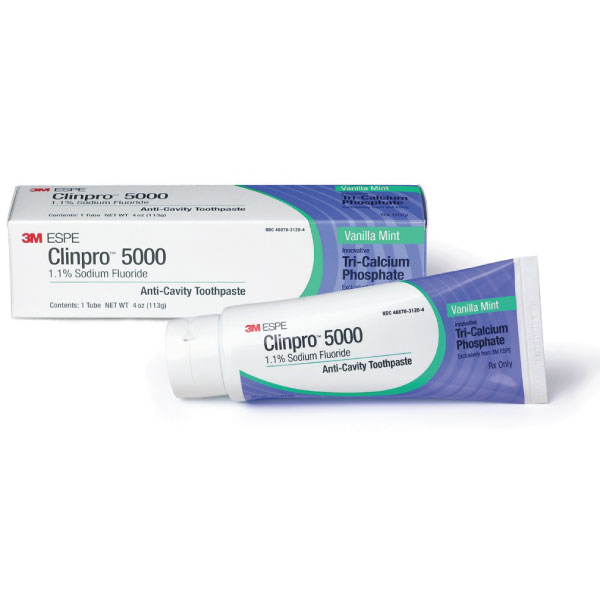
FESEM Analysis Cinches Case for Toothpaste’s Potential New Claims
At a Glance
McCrone Associates, Inc. used field emission scanning electron microscopy (FESEM) to provide visual, nano-scale evidence for patient-reported hypersensitivity benefits of a new, professional-strength toothpaste.
Situation
Robert Karlinsey, Ph.D. founded a company built around a new calcium phosphate technology that is incorporated in a professional-strength, cavity-fighting toothpaste called Clinpro 5000. Through a partnership with 3M ESPE’s dental division, dentists, orthodontists and other dental professionals sell Clinpro 5000 in their offices.
Dr. Karlinsey says patients brushing with Clinpro 5000 reported that sensitivity in their teeth subsided dramatically. Dental hypersensitivity can arise when a tooth’s outer layer demineralizes due to abrasion, wear or acid attack. This demineralization exposes nerves to stimuli via microscopic pores called dentin tubules.
Following the unexpected patient reports, 3M conducted a pilot clinical study confirming Clinpro 5000 reduced hypersensitivity to temperature, pressure and touch.
Issue
Dr. Karlinsey wanted to investigate what was behind the hypersensitivity reduction. One possibility was that Clinpro plugged the tubules with deposits of fluoride and the functionalized tricalcium phosphate ingredient. Clinpro had previously been observed to have a mineral building effect in patients with cavities. The difference is that in cavities, the effect was in hard tissue (i.e. the enamel). The hypersensitivity study implied that the toothpaste might have a similar effect in dentin, a soft tissue.
Solution
Dr. Karlinsey had previously consulted with McCrone Associates for nanoscale analysis of enamel structure before and after treatment with Clinpro’s tricalcium phosphate and fluoride mineral combination.
“McCrone Associates scientists really know what they’re talking about,” said Dr. Karlinsey. “I had worked with Craig Schwandt and I thought he was really fantastic.”
Craig Schwandt, Ph.D. specializes in X-ray microanalysis of particles using energy and wavelength dispersive spectrometry methods with the scanning electron microscope and electron microprobe.
Dr. Karlinsey wanted to use state-of-the-art technology and Dr. Schwandt’s expertise to visually demonstrate Clinpro’s hypersensitivity benefits. His question was simple: “Do we have minerals that are being deposited into the pores?”
He began by subjecting demineralized dentin to two different kinds of treatment with toothpastes that claimed to have hypersensitivity benefits. The first treatment aimed to see if mineral deposits could form in the tubules. The second treatment determined whether such deposits could withstand an acid challenge.
Dr. Karlinsey once again turned to collaborator Dr. Schwandt for his imaging expertise. He provided Dr. Schwandt with samples without revealing their identity, and did not reveal the outcome until after all the data were collected.
Dr. Schwandt relied on Field Emission Scanning Electron Microscopy (FESEM) to image and analyze coded samples supplied by Dr. Karlinsey. He was able to analyze each sample within minutes, and altogether analyzed more than 70 samples.
According to Dr. Schwandt, techniques such as SEM only allow you to see down to 300 nanometers, or 0.3 micrometers resolution. FESEM, with its finer electron source, enables scientists to view objects down to 1 nanometer.
Throughout the process, Dr. Schwandt worked iteratively with Dr. Karlinsey.
“Although Craig didn’t have significant experience working with dentin, when viewing the images, I told him what I liked, what I didn’t like, whether we could zoom in or out, could we look inside structures,” said Dr. Karlinsey.
“At the end of the day, I got an excellent view of the pores and tubules.”
Results
Dr. Schwandt remarked, “We were able to demonstrate for Dr. Karlinsey that the Clinpro 5000 product was getting into dentin tubules.”
The FESEM images showed that the toothpaste’s ingredients got into the tubules and blocked them, which could explain the hypersensitivity benefits. His analyses also showed that the deposits were acid-resistant.
Dr. Karlinsey and Dr. Schwandt published their findings in the December 2011 issue of American Journal of Dentistry. Now the dental community and 3M have visual proof of Clinpro 5000’s patient-reported hypersensitivity benefits.
Dr. Karlinsey remarked: “I love McCrone Associates and I will use them again. They’re stand-up people and deliver really high-quality work.”